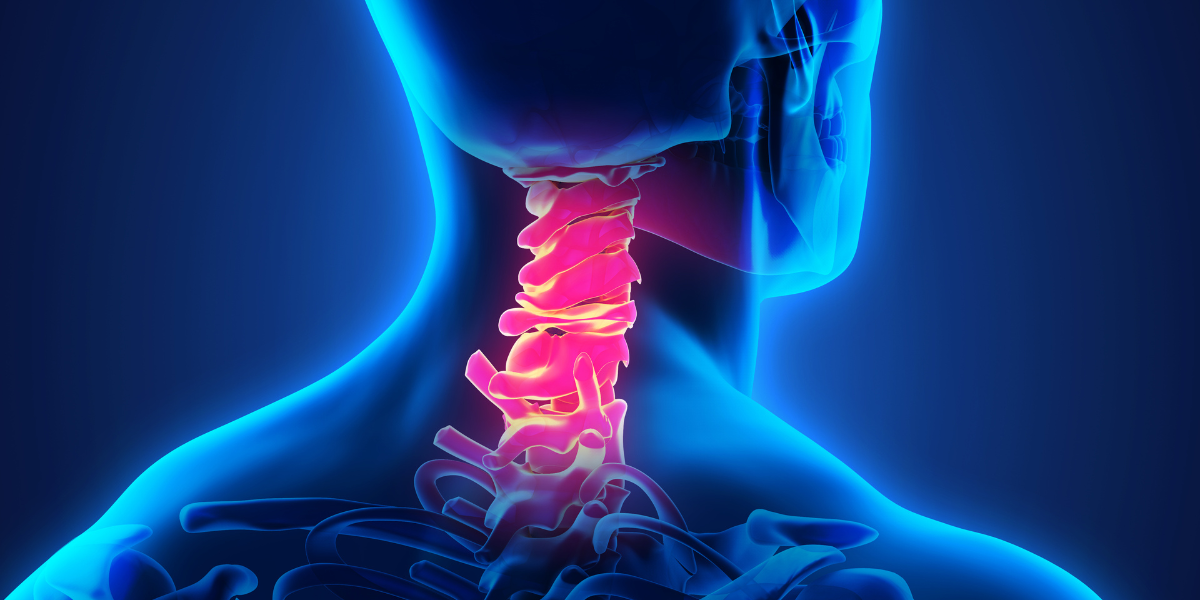
Auto Accident Neck Injuries – What You Need to Know
As skilled Kansas City auto accident injury trial lawyers, we see a multitude of serious injuries caused by negligent drivers. Some of the most common injuries we see involve the neck or cervical spine. These injuries can range from whiplash to cervical fractures. Injuries to the cervical spine can be debilitating and cause permanent disabilities. If you have suffered a neck injury caused by a negligent driver, it’s important to seek legal counsel as soon as possible to ensure you are awarded the compensation you deserve.
Common Cervical Spine Injuries
Car accidents can lead to a variety of cervical spine injuries due to the sudden and forceful movements involved. Some common cervical spine injuries from car accidents include:
- Whiplash: This is the most common cervical spine injury in car accidents. It occurs when the head is suddenly jerked back and forth beyond its normal limits, stretching and tearing the soft tissues (muscles, tendons, and ligaments) of the neck.
- Cervical Fractures: A cervical fracture refers to a break in one of the cervical vertebrae. High-impact collisions can cause these fractures, which may lead to serious complications including spinal cord damage.
- Cervical Dislocation: This injury involves the displacement of one or more vertebrae, which can disrupt the alignment of the spine. This is often associated with significant ligament injury and can also affect the spinal cord.
- Cervical Strain: Similar to whiplash, this is an injury to the muscles and ligaments in the neck due to overextension. Cervical strain differs in that it typically involves more muscle damage and can take longer to heal.
- Herniated Disc: The cervical discs can herniate or rupture due to the impact, causing the inner gel-like material of the disc to escape and press on the spinal cord or nerve roots. This can cause pain, numbness, or weakness in the arms or hands.
- Spinal Cord Injury: Severe impacts can cause damage to the spinal cord in the neck region, which can result in partial or complete paralysis below the level of the injury.
The severity of these injuries can vary widely, from minor issues that resolve with time to serious, long-term conditions that require extensive medical treatment. Immediate medical assessment after a car accident is crucial to diagnose and treat any potential injuries to the cervical spine.
Why Are Neck Injuries Common in Car Wrecks?
Cervical spine injuries in car accidents are primarily caused by the forceful and rapid movement of the head and neck during collisions. Here’s a breakdown of the typical mechanisms that lead to these injuries:
- Acceleration-Deceleration Forces (Whiplash): This occurs in rear-end collisions where the impact causes the head to snap backward and then forward. This sudden movement can stretch and tear the neck’s muscles and ligaments, potentially harming the vertebrae and the spinal cord.
- Direct Impact: Inside collisions or frontal impacts, the head may strike an object like a steering wheel, dashboard, or window. This direct force can cause fractures, dislocations, and other traumatic injuries to the cervical spine.
- Compression: This type of injury results from a severe and sudden force that compresses the spine vertically, often seen in rollover accidents or when the roof collapses during a crash. Compression can lead to fractured vertebrae and damage to the spinal cord.
- Rotation: Twisting of the neck during an accident can lead to tearing of the ligaments and muscles around the cervical spine. It can also stress the spinal discs, leading to herniations or other disc injuries.
- Penetrating Injuries: Although less common, objects that penetrate the body during an accident, such as shards of glass or metal, can directly injure the spinal cord or cervical vertebrae.
The dynamics of a car accident — including the direction and speed of the impact, the position of the head and neck, and whether seat belts or airbags were used — all influence the specific type and severity of cervical spine injuries. Prompt medical attention after an accident is essential to assess and address any injuries effectively.
Cervical Spine Injury Susceptibility
The cervical spine is particularly susceptible to injuries in car accidents due to its structure and range of motion. Here are some factors that contribute to its vulnerability:
- Anatomical Structure: The cervical spine consists of seven vertebrae (C1-C7) at the top of the spine that support the skull and enable head movement. This section of the spine is less protected compared to other parts, like the thoracic spine, which is shielded by the rib cage.
- Range of Motion: The cervical spine allows for extensive mobility in multiple directions, including flexion, extension, rotation, and lateral bending. This flexibility, while crucial for head movement, also makes it more susceptible to injury during sudden, forceful motions that occur in accidents.
- Positioning During Impact: During a car crash, the head and neck can move abruptly and excessively before the rest of the body, due to their position and lack of direct support. This can lead to overextension or compression of the cervical spine.
- Force of Impact: The force exerted in a car accident can be substantial, and the neck may not withstand the rapid acceleration-deceleration forces. This can lead to soft tissue injuries, fractures, and other structural damage to the cervical vertebrae and surrounding areas.
- Lack of Direct Protection: Unlike other parts of the body that might be somewhat protected by seat belts and airbags, the neck can still experience significant movement and force in an accident, even when other safety measures are in place.
Due to these factors, the cervical spine is highly vulnerable in car accidents, which can lead to a variety of injuries, from minor strains to severe spinal damage. This is why vehicle safety measures such as headrests and properly adjusted seat belts are crucial in helping to reduce the risk of cervical spine injuries during collisions.
What is a Cervical Fracture?
A cervical fracture involves a break in one or more of the cervical vertebrae—the bones that make up the neck portion of the spine. The cervical spine is especially vulnerable in vehicle collisions due to its flexibility and the potential for high-impact forces to affect the neck.
Causes of Cervical Fractures in Vehicle Collisions
While commercial vehicles are often involved in severe crashes due to their size and weight, non-commercial vehicles can also be responsible for significant accidents leading to cervical fractures. Here are some common scenarios:
- High-speed crashes: Whether involving a single car or multiple vehicles, the higher the speed at impact, the greater the force exerted on occupants, increasing the risk of neck fractures.
- Rear-end collisions: This common type of accident can cause whiplash, which may not only lead to soft tissue injuries but also to fractures if the force is severe enough.
- T-bone accidents and rollovers: These accidents can cause the head to move violently from side to side or even be thrown from the vehicle, leading to direct trauma to the cervical spine.
Symptoms of Cervical Fractures
The symptoms of a cervical fracture can vary depending on the severity of the injury but typically include:
- Pain and tenderness at the back of the neck
- Reduced range of motion
- Numbness or tingling sensations in the arms or legs
- Muscle weakness
- Difficulty with coordination and balance; in severe cases, may lead to paralysis
- Trouble breathing or swallowing, which requires immediate medical attention
If any of these symptoms occur following a vehicle accident, it’s crucial to seek medical care without delay.
Immediate Steps to Take After a Vehicle Collision
If you suspect a cervical fracture after a vehicle accident in Kansas City, taking the right steps promptly can help mitigate further injury and facilitate a more effective recovery:
- Remain still: Avoid moving if you suspect a neck injury. Movement can worsen the injury.
- Call 911: Immediate medical attention is critical, as professionals can properly immobilize the neck and transport you safely.
- Immobilize your neck: If you must wait for help, keep your neck as still as possible in a neutral position.
- Document the accident: Once stabilized, collect as much information as possible about the accident, including taking photos, noting your recollections of the event, and gathering witness details.
Treatment Recovery Roadmap
A cervical fracture, often referred to as a broken neck, is a serious condition resulting from trauma such as a car accident. The treatment and recovery outlook vary depending on the severity and specifics of the fracture. Here’s an overview:
Treatment
- Immobilization: Initially, to prevent further injury and stabilize the spine, a cervical collar or neck brace may be used. In cases where there are concerns about spinal stability, traction might be necessary.
- Medication: Pain management is crucial. Patients are typically given pain relievers and, in some cases, medications to reduce inflammation.
- Surgery: In more severe cases, such as when there is damage to the spinal cord or instability in the spine, surgery may be required. Surgical procedures might involve repairing and stabilizing the cervical vertebrae with screws, plates, or rods.
- Rehabilitation: Post-treatment, rehabilitation plays a critical role. This may include physical therapy to regain strength and mobility, occupational therapy to assist with daily activities, and possibly speech therapy if there are swallowing or speaking difficulties.
Recovery Outlook
- Severity of Injury: The recovery largely depends on the severity of the fracture and any associated spinal cord injury. Simple fractures without spinal cord damage have a better prognosis than those with such damage.
- Speed and Quality of Medical Response: Early and effective treatment improves the chances of a good outcome. Delays in treatment can lead to worse outcomes.
- Rehabilitation Efforts: Consistent and comprehensive rehabilitation can greatly aid recovery, helping regain as much function as possible.
- Individual Factors: Age, overall health, and pre-existing conditions also significantly influence recovery.
Long-term Considerations
Some individuals may recover fully, regaining all or most of their pre-injury function. However, others may experience long-term effects, including reduced mobility, chronic pain, or partial to complete paralysis. The emotional and psychological impact of such a traumatic injury also requires attention and care.
Each case is unique, and the medical team involved will tailor treatment plans to the individual’s specific needs. Patients and their families need to be closely involved with the medical team to understand the treatment options and prognosis.
Estimated Medical Costs
The cost of treating a cervical fracture resulting from a car accident can vary widely depending on several factors including the severity of the injury, the type of medical care required, the length of hospital stay, whether surgery is needed, and the extent of rehabilitation services required. Here’s a breakdown of potential costs:
Initial Treatment
- Emergency Care: Immediate treatment, including emergency transport and initial hospital care, can range from a few thousand dollars to over $10,000 depending on the complexity of the injury and the tests performed.
- Surgery: If surgery is required to stabilize the neck, costs can significantly increase. Spinal surgeries can cost anywhere from $20,000 to $150,000 or more, depending on the procedure and complications that might arise.
Hospital Stay
- Hospitalization Costs: A prolonged stay in a hospital, especially in an intensive care unit (ICU), can be extremely costly. Daily ICU costs can exceed $3,000, and a typical stay for severe injuries might last from a few days to several weeks.
Rehabilitation
- Physical Therapy: Ongoing physical therapy is often necessary for recovery and can range from $50 to $350 per session, with multiple sessions per week over several months or even years.
- Occupational and Other Therapies: Additional costs for occupational therapy, speech therapy, and other rehabilitation services can add up quickly.
Additional Costs
- Medical Equipment: Costs for medical equipment such as wheelchairs, home modifications for disability access, and long-term medications for pain and other complications.
- Follow-up Care: Regular follow-up visits with specialists, which may continue for years.
- Lost Wages and Productivity: Not directly a medical cost, but significant for many individuals, especially if the injury results in long-term disability.
Insurance and Financial Assistance
In many cases, health insurance will cover a substantial portion of these costs, though the specifics depend on the insurance plan’s details like deductibles, copays, and coinsurance. In the absence of insurance, these costs can be financially devastating. Financial assistance might be available through hospital financial aid programs, charitable organizations, or through state disability benefits for qualifying individuals.
Overall, the financial impact of a cervical fracture can be substantial, easily running into hundreds of thousands of dollars when considering all factors of immediate and long-term care.
Legal Considerations in Kansas and Missouri
Neck injuries resulting from vehicle collisions can be devastating. Being informed about the causes, symptoms, and critical first steps to take after an accident can greatly influence the recovery process and legal outcomes. If you’re in Kansas City and find yourself in such a situation, prioritize your health and seek professional guidance to navigate the complexities of medical and legal recovery.
Dealing with the aftermath of a vehicle collision that results in a permanent neck injury involves navigating insurance claims and potential legal actions. Whether the collision involved a commercial or a private vehicle, residents of Kansas City should consider contacting a skilled Kansas City personal injury trial attorney as soon as possible to protect their rights and ensure they are awarded the compensation they deserve.
Contact our firm for a free consultation and we will leave no stone unturned in the pursuit of your recovery. (816) 531-3100
Additional Resources
The Impact of Delayed & Gapped Treatment in Missouri & Kansas Car Accident Injury Claims
Navigating Medical Payment Coverage (MedPay) in Kansas and Missouri
Kansas Personal Injury Protection (PIP) Coverage Explained
Understanding Your Medical Bills After a Personal Injury
The Impact of Delayed & Gapped Treatment in Missouri & Kansas Car Accident Injury Claims






